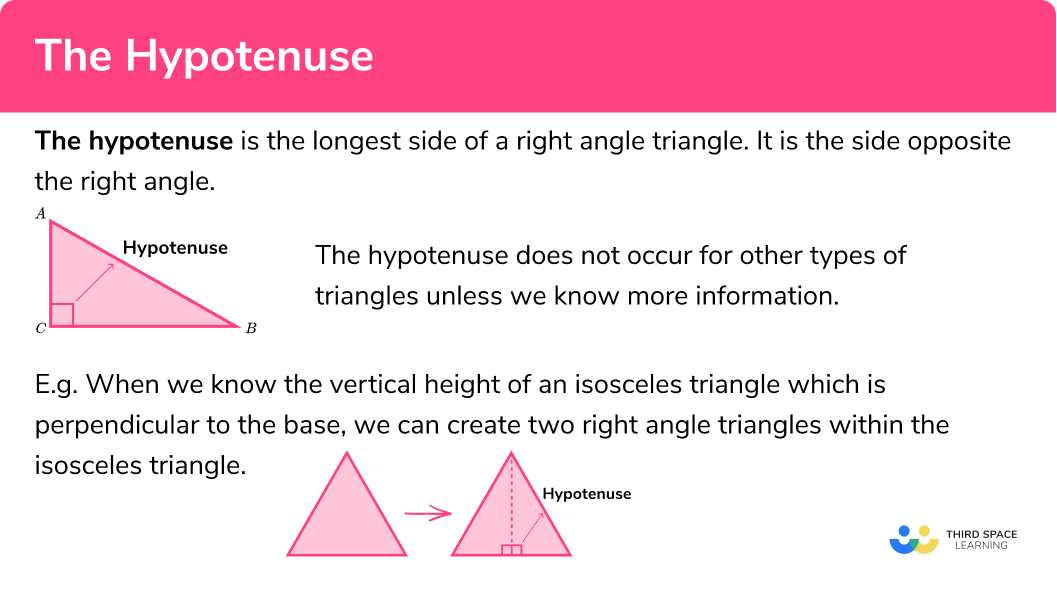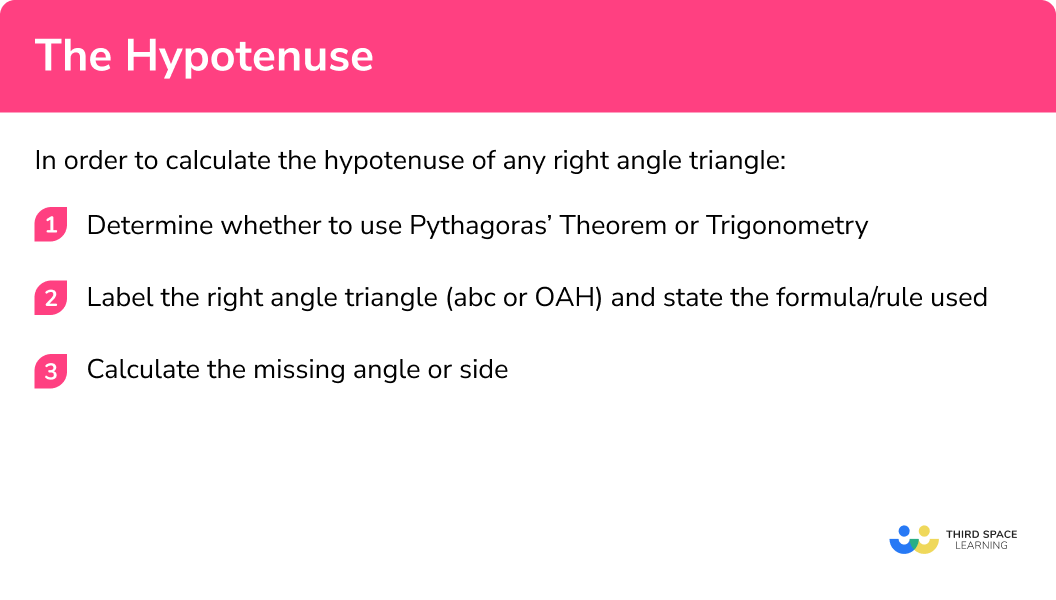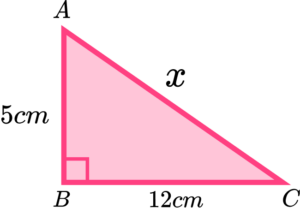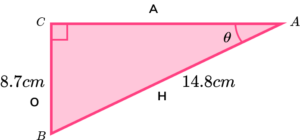GCSE Tutoring Programme
Our chosen students improved 1.19 of a grade on average - 0.45 more than those who didn't have the tutoring.
In order to access this I need to be confident with:
Trigonometric functions Pythagoras theorem Exact trig values Surds Square numbers and square rootsThis topic is relevant for:

Hypotenuse
Here we will learn about the hypotenuse including how to find the length of the hypotenuse, how to use the hypotenuse to find other missing sides and angles in right angle triangles and how to calculate other values such as the volume or perimeter using the hypotenuse.
There are also hypotenuse worksheets based on Edexcel, AQA and OCR exam questions, along with further guidance on where to go next if you’re still stuck.
What is the hypotenuse?
The hypotenuse is the longest side of a right angle triangle. It is the side opposite the right angle.
For example,
When we know the vertical height of an isosceles triangle which is perpendicular to the base, we can create two right angle triangles within the isosceles triangle.
What is the hypotenuse?

Hypotenuse in 2D and 3D Shapes
We can also calculate diagonals in 2D and 3D shapes by recognising right-angle triangles.
For example,
We can find the diagonal length
Pythagoras or trigonometry?
We need to be able to interpret problems and recognise whether we need to use Pythagoras theorem in 2D, 3D, or one of the three trigonometric ratios.
This flow chart describes the information you need to know about a shape in order to solve the problem.
It is important to recognise that with most of these problems, you may need to use the Pythagorean theorem, or trigonometry, or both within the same question so you must be confident with these topics individually to access this topic fully.
Below is a summary of this information,
| Name | Used to find. . . | Rule or formula |
|---|---|---|
| Pythagoras theorem in 2D | The hypotenuse (c) A shorter side (a) | \\c=\sqrt{a^{2}+b^{2}} \\a=\sqrt{c^{2}-b^{2}} |
| Sine function | Missing side: Hypotenuse (H) or Opposite (O) | \\H=\frac{O}{\sin(\theta)}\\ \\O=H\times\sin(\theta) |
| Cosine function | Missing side: Hypotenuse (H) or Adjacent (A) | \\H=\frac{A}{\cos(\theta)}\\ \\A=H\times\cos(\theta) |
| Tangent function | Missing side: Adjacent (A) or Opposite (O) | \\A=\frac{O}{\tan(\theta)}\\ \\O=A\times\tan(\theta) |
| Inverse sine function | Missing angle (\theta) | \theta=\sin^{-1}(\frac{O}{H}) |
| Inverse cosine function | Missing angle (\theta) | \theta=\cos^{-1}(\frac{A}{H}) |
| Inverse tangent function | Missing angle (\theta) | \theta=\tan^{-1}(\frac{O}{A}) |
| Pythagoras theorem in 3D | The diagonal (D) | \\D=\sqrt{x^{2}+y^{2}+z^{2}} |
Step-by-step guide: Trigonometry
Step-by-step guide: 3D trigonometry
How to calculate the hypotenuse of any right angle triangle
In order to calculate the hypotenuse of any right angle triangle:
- Determine whether to use Pythagoras theorem or trigonometry.
- Label the right angle triangle
(abc or OAH) and state the formula/rule used. - Calculate the missing angle or side.
Explain how to calculate the hypotenuse of any right angle triangle


Hypotenuse worksheet

Get your free hypotenuse worksheet of 20+ questions and answers. Includes reasoning and applied questions.
DOWNLOAD FREE
Hypotenuse worksheet

Get your free hypotenuse worksheet of 20+ questions and answers. Includes reasoning and applied questions.
DOWNLOAD FREEHypotenuse examples
Example 1: find the hypotenuse using Pythagoras theorem
Calculate the value of x to 1 decimal place.
- Determine whether to use Pythagoras theorem or trigonometry.
We know two missing sides of the right angle triangle and no other angles so we can use Pythagoras theorem.
2Label the right angle triangle
As we are using Pythagoras theorem, label the sides a, b, and c (the opposing side to the right angle).
Pythagoras theorem, c=\sqrt{a^{2}+b^{2}} .
3Calculate the missing angle or side.
\begin{aligned} c&=\sqrt{7.3^{2}+12.5^{2}}\\\\ c&=\sqrt{53.29+156.25}\\\\ c&=\sqrt{209.54}\\\\ c&=14.5\mathrm{cm}\quad(1dp) \end{aligned}Example 2: find the hypotenuse using trigonometry
Calculate the length of the hypotenuse of a right triangle, x , to 1 decimal place.
Determine whether to use Pythagoras theorem or trigonometry.
We know one missing side of the right angle triangle and one acute angle so we can use trigonometry to find the hypotenuse.
Label the right angle triangle (abc or OAH) and state the formula/rule used.
As we are using trigonometry, label the sides opposite, adjacent and hypotenuse according to the location of the known angle.
The two important sides in this question are the opposite side (O) and the hypotenuse (H) so we need to use the sine function to calculate the value of x .
Sine function, H=\frac{O}{\sin(\theta)} .
Calculate the missing angle or side.
Example 3: find the diagonal of a quadrilateral
ABCD is a parallelogram. Calculate the length of the longer diagonal AC to 2 decimal places.
Determine whether to use Pythagoras theorem or trigonometry.
From the information given in the diagram, we first need to calculate the base of the triangle CDX. We can then use this to find the length AC.
So we need to find the base of the triangle CDX.
As we know one side and one angle, to calculate the base we need to use a trigonometric ratio.
Label the right angle triangle (abc or OAH) and state the formula/rule used.
Here we are using the tangent function as we know the opposite side to the angle and we are calculating the adjacent side.
Tangent function, A=\frac{O}{\tan(\theta)} .
Calculate the missing angle or side.
The missing side x is therefore equal to,
\begin{aligned} A&=\frac{O}{\tan(\theta)}\\\\ x&=\frac{5}{\tan(40)}\\\\ x&=5.95877\mathrm{cm}\quad (5dp) \end{aligned}
As the distance DX = 5.95877cm (5dp), AX = 10 + 5.95877= 15.95877cm (5dp) .
Using this information, we now can draw the triangle ACX and calculate the length of AC.
Determine whether to use Pythagoras theorem or trigonometry.
We know two sides of the right angle triangle ACX and as we need to find the length of AC, we use Pythagoras theorem in 2D.
Label the right angle triangle (abc or OAH) and state the formula/rule used.
Labelling the sides of the triangle a, b, c (remember c is always the hypotenuse).
Pythagoras theorem, c=\sqrt{a^{2}+b^{2}} .
Calculate the missing angle or side.
Example 4: find the diagonal of a cuboid using 3D Pythagoras
Calculate the length of the diagonal AH. Write your answer in the form a\sqrt{b}cm where a and b are integers.
Determine whether to use Pythagoras theorem or trigonometry.
We know all three of the dimensions of this cuboid (height, width and depth) and so we can use Pythagoras theorem in 3D to calculate the length of AH.
Remember that Pythagoras theorem in 3D is the sum of the squares of the lengths of the cuboid.
Label the right angle triangle (abc or OAH) and state the formula/rule used.
Here, as we are using Pythagoras theorem in 3D and we know the side lengths of the cuboid, we can just state the theorem.
Pythagoras theorem (3D), AH=\sqrt{x^{2}+y^{2}+z^{2}} .
Calculate the missing angle or side.
Example 5: find the missing length using trigonometry in 3D
ABCDEF is a triangular prism. Calculate the length of the line CF, correct to 3 significant figures..
Determine whether to use Pythagoras theorem or trigonometry.
From the information given in the diagram, we first need to calculate the length of CE. We can then use this to find the length CF.
So we need to find the hypotenuse of the initial triangle.
As we know one side and one angle, to calculate the hypotenuse we need to use a trigonometric ratio.
Label the right angle triangle (abc or OAH) and state the formula/rule used.
Here we are using the sine function as we know the opposite side to the angle and we are calculating the hypotenuse.
Sine function, H=\frac{O}{\sin(\theta)} .
Calculate the missing angle or side.
The missing side x is therefore equal to,
\begin{aligned}
H&=\frac{O}{\sin(\theta)}\\\\
x&=\frac{5}{\sin(30)}\\\\
x&=10\mathrm{cm}
\end{aligned}
Now we know the length CE, we can use this information to draw the triangle CEF and hence calculate the length of CF.
We know that angle BCE is a right angle, so angle FCE must be 20.
Determine whether to use Pythagoras theorem or trigonometry.
We know one side and one angle in the right angle triangle
Label the right angle triangle (abc or OAH) and state the formula/rule used.
Labelling the sides of the triangle O, A and H.
Cosine function, H=\frac{A}{\cos(\theta)} .
Calculate the missing angle or side.
Example 6: calculating the diagonal of a 3D shape, given the volume
The cube shown has a volume of 648\sqrt{3}\mathrm{cm}^{3} . Calculate the length of the diagonal AH.
Determine whether to use Pythagoras theorem or trigonometry.
To find the diagonal we need to know the side length of the cube. We can calculate this by using the volume.
The volume of a cube is calculated by cubing a side length, so in order to calculate the side length EH we need to cube root the volume given by 648\sqrt{3}\mathrm{cm}^{3} .
EH =\sqrt[3]{648\sqrt{3}}
EH =6\sqrt{3}\mathrm{cm}
Each side length of the cube is equal to 6\sqrt{3}\mathrm{cm}^{3} so we can use Pythagoras theorem in 3D as we know the height, width and depth of the shape.
Label the right angle triangle (abc or OAH) and state the formula/rule used.
As we are using Pythagoras theorem in 3D and we know the side lengths of the cube so we can just state the theorem.
Pythagoras theorem (3D), AH=\sqrt{x^{2}+y^{2}+z^{2}} .
Calculate the missing angle or side.
Common misconceptions
- Pythagoras theorem or trigonometry
It is a common error to mix up when to use Pythagoras and when to use trigonometry.
Remember in order to use Pythagoras to calculate the unknown side of a right angled triangle we need to know the other two sides.
In order to use trigonometry to calculate the unknown side of a right angled triangle we need to know another side and an angle.
- Incorrectly applying Pythagoras theorem
For example, given the triangle with base 15cm and vertical height 22cm , possible incorrect calculations for the hypotenuse could be:
c=\sqrt{22^{2}-15^{2}}Or
c=\sqrt{22^{2}\times15^{2}}The correct calculation is c=\sqrt{22^{2}+15^{2}} = 26.6 (1dp).
- Incorrect trigonometric function
For example, given the triangle below, a possible error would be to incorrectly use the tangent function instead of the cosine function to find the value of x .
Hypotenuse practice questions
1. Triangle ABC is a right angle triangle. Calculate the value of x .





This is a right angled triangle and we do not know any of the angles so we need to use Pythagoras theorem.
\begin{aligned} c^{2}&=a^{2}+b^{2}\\\\ x^{2}&=5^{2}+12^{2}\\\\ x^{2}&=25+144\\\\ x^{2}&=169\\\\ x&=13\mathrm{cm} \end{aligned}
2. Calculate the value of \theta to 2 significant figures.




This is a right angled triangle and we are working out the size of an angle so we need to use SOHCAHTOA.
Label the triangle,

We know O and H so use sine.
\begin{aligned} \sin(\theta)&=\frac{O}{H}\\\\ \sin(\theta)&=\frac{8.7}{14.8}\\\\ \theta&= \sin^{-1}(\frac{8.7}{14.8})\\\\ \theta&=36^{\circ} (2sf) \end{aligned}
3. ABCD is a trapezium with diagonal length 10cm .
Calculate \theta , the external angle of the polygon at B , correct to 2 decimal places.




First we need to calculate the height of the trapezium. We can do this using the following triangle,

The triangle is a right angled triangle and we know an angle so we need to use SOHCAHTOA. We want to work out O and we know H so use sine.
\begin{aligned} O&=H \sin(\theta)\\\\ O&=10 \sin(24)\\\\ O&=4.067366431 \end{aligned}
We can now use the height, along with the information we have been given to find the angle.

We know O and A so use tan.
\begin{aligned} \tan(\theta) &= \frac{O}{A}\\\\ \tan(\theta)&=\frac{4.067366431}{3}\\\\ \theta&=\tan^{-1}(\frac{4.067366431}{3})\\\\ \theta&=53.59^{\circ} (2dp) \end{aligned}
4. A swimming pool is the shape of a trapezoidal prism. A sketch of the swimming pool is drawn below.
Calculate the longest distance in the pool, AH , correct to 3 significant figures.




Here we need to calculate the diagonal length of a 3D shape for which we know the length, width and depth. We can apply Pythagoras theorem in 3D.
\begin{aligned} D^{2}&=x^{2}+y^{2}+z^{2}\\\\ D^{2}&=30^{2}+40^{2}+60^{2}\\\\ D^{2}&=6100\\\\ D&=78.1\mathrm{ft} \end{aligned}
5. ABC and ADE are two right angle triangles where AD = \frac{2}{3}AC .
By calculating the length of AD , find the value of \theta .




First we need to calculate the length AC,
ABC is a right angled triangle and we know an angle so we can use SOHCAHTOA.
We know A and we want to work out O so use tan.
\begin{aligned} O&=A\tan{\theta}\\\\ O&=5\sqrt{3}\tan{60}\\\\ O&=15\mathrm{cm} \end{aligned}
We are told that AD=\frac{2}{3}AC .
Therefore AD=\frac{2}{3} \times 15=10\mathrm{cm} .
Now that we know the length AD , we can use the triangle ADE to work out the required angle.
We know O and H so use sin.
\begin{aligned} \sin(\theta)&=\frac{O}{H}\\\\ \sin(\theta)&=\frac{10}{10\sqrt{2}}\\\\ \theta&=\sin^{-1}(\frac{10}{10\sqrt{2}})\\\\ \theta&=45^{\circ} \end{aligned}
6. The surface area of a cube below is equal to 150cm^2 . Find the diagonal length BE . Give your answer in surd form.




This is a cube therefore all 6 faces are the same. If the surface area is 150cm^2 , then the area of each face is 150\div 6=25\mathrm{cm}^{2} and the length of each side is \sqrt{25}=5\mathrm{cm} .
We can then use Pythagoras theorem in 3D to find the length of the diagonal,
\begin{aligned} D^{2}&=x^{2}+y^{2}+z^{2}\\\\ D^{2}&=5^{2}+5^{2}+5^{2}\\\\ D^{2}&=75\\\\ D&=5\sqrt{3} \mathrm{cm} \end{aligned}
Hypotenuse GCSE exam questions
1. Circle the correct expression for the perimeter of the kite ABCD .
\begin{aligned} 26+\frac{10\sqrt{3}}{3}\mathrm{cm} \quad \quad 22+\frac{\sqrt{3}}{15}\mathrm{cm} \quad \quad 125cm \quad \quad 46cm \quad \quad 60+5\sqrt{3}\mathrm{cm} \end{aligned}
(3 marks)
(1)
\begin{aligned} BC&=\sqrt{5^{2}+12^{2}}\\\\ BC&=13\mathrm{cm} \end{aligned}(1)
Total perimeter = 10+10+13+13 = 46cm
(1)
2. ABCDE is a square based pyramid with the following details,
- M is the midpoint of BC .
- O is the centre of the square BCDE .
- AM = 42cm.
- BCDE has sides of length 16cm .
(a) Calculate the vertical height of the pyramid, OA .
Write your answer in the form a\sqrt{b} where a and b are integers.
(b) Show that AM<AB .
(6 marks)
(a)
(1)
OA = \sqrt{42^{2}-8^{2}}(1)
OA = 10\sqrt{17}cm(1)
(b)
AB = \sqrt{42^{2}+8^{2}}
(1)
AB = 2\sqrt{457} = 42.755cm\quad(3dp)(1)
AM=42cm and AB=42.755cm so AM<AB.
(1)
3. Two cubes are drawn in the diagram below.
Show that BE = 3.8KN .
(3 marks)
(1)
KN=\sqrt{3.8^{2}+3.8^{2}+3.8^{2}} = \frac{19\sqrt{3}}{5}(1)
\frac{19\sqrt{3}}{5}\div{\sqrt{3}}=\frac{19}{5}=3.8(1)
Learning checklist
You have now learned how to:
-
Use Pythagoras theorem and trigonometric ratios in similar triangles to solve problems involving right-angled triangles
-
Apply Pythagoras theorem and trigonometric ratios to find angles and lengths in right-angled triangles (and, where possible, general triangles) in 2 (and 3) dimensional figures
The next lessons are
Still stuck?
Prepare your KS4 students for maths GCSEs success with Third Space Learning. Weekly online one to one GCSE maths revision lessons delivered by expert maths tutors.

Find out more about our GCSE maths tuition programme.